Growing Up with Radio Shack
I saw in the online Wall Street Journal that Radio Shack is preparing to file for bankruptcy:
http://www.wsj.com/articles/radioshack-prepares-bankruptcy-filing-1421279360
I had read a blog post eulogizing the store from a former employee several weeks ago. I ended up on the Radio Shack Catalogs site:
http://www.radioshackcatalogs.com/
…poring over old catalogs, looking at all of the gear that I’d purchased throughout my childhood and through the early years of my adult life. Reminiscing brought back some good memories.
My first purchases at the store were educational science kits that were sold for twenty-five cents apiece. I was five or six years old at this time. I would do some work around the house to earn the quarter … then, my brother would take me to Radio Shack to buy a kit.
I had one that was geared toward plant-life and included several small bottles of seeds. ( I remember rye seeds, for some odd reason. ) Another kit contained magnets and iron powder. I think I had a couple more, but I can’t remember them, clearly.
I wasn’t really much of a consumer until several years later. My brother gave me his old Radio Shack Cassette recorder:

My first purchases included a dynamic microphone for the recorder. I might’ve also purchased a universal AC adapter at this point, too.
As I was reaching my teenage years, I had become very interested in radio technology. I was particularly fascinated with shortwave radios. I found it amazing that one could listen to people from all over the world. I also became interested in Citizen’s Band radios, the aircraft band, …etc.
One of my first kit purchases was a radio / amplifier kit.
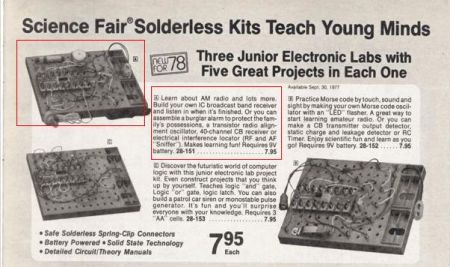
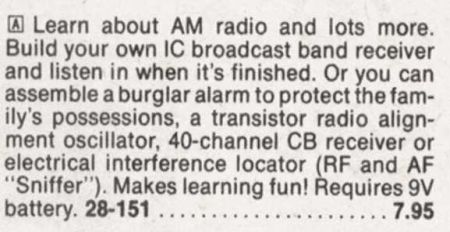
The kit used Radio Shack’s signature no-solder spring-clip technology which made piecing together circuits very easy. The components were all mounted on a plastic board with the leads for each component inserted into the underside of the spring. To construct a project, one needed to place wires in the springs to connect the components together.
I did build all of the projects. The CB receiver wasn’t great, but I was able to hear some CB’ers before I tore the project apart to build another. The project that entertained me the most was the electrical interference detector. When you held the project board with the finished project near a source of electrical energy ( an electrical appliance or wires in the walls ) a radio station would play through the earphone.
The kit included a crystal radio circuit. It wasn’t my first crystal radio, but I continued to be astounded at the simplicity of the circuit which required no battery. The radio signals were powerful enough to drive the crystal earphone after connecting the circuit to a ground ( usually the finger-stop clip on a rotary phone .)
I combined two of the circuits in this kit and ended up with a very loud crystal radio. This was completely by accident … I didn’t understand any of the theory well enough to have designed this properly.
It was probably at this point that I joined one of the “free battery club” offerings.

I was able to get one free battery per month using this card. As I recall, the batteries I got seemed to be of poor quality, but hey; they were free.
Later, Radio Shack gave away a “free” flashlight with a coupon from a Sunday newspaper ad insert. I went to get one only to find that the base of the flashlight was enormous and required several batteries.
I later bought an AM radio kit that required soldering. I hadn’t realized that the wire for the construction was not supplied with the kit. I never finished the project.
I had a couple of 100-milliwatt walkie-talkies from another manufacturer that used CB channel 14. You pretty much had to be within a city block of each other in order to talk. Radio Shack advertised a 49 MHZ walkie-talkie that I thought would be cool.
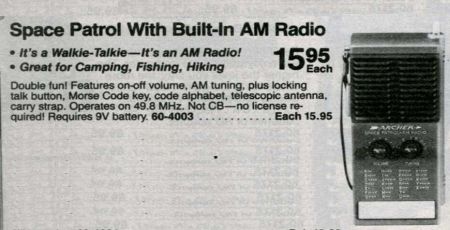
…it wasn’t. Yes, it had an AM radio which still had some value at the time. It also had a Morse code key and a listing of the code on a plate on the front of the unit. However, there was no one broadcasting locally on this channel.
I tried to de-solder the crystals and replace them with channel 14 crystals, but that just plain didn’t work. I ended up ruining the unit.
I didn’t have enough money for one of the larger kits, but I got together enough to buy a 10-in-one kit:
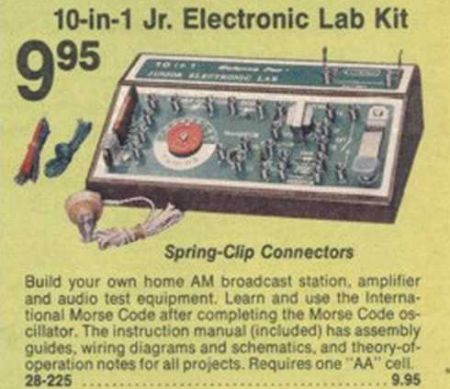
There were a couple of AM radio projects that I’d already done, but the AM radio broadcast station project proved to be valuable. My stereo had broken, so for a while, I cobbled together a wire that plugged into my old cassette recorder and would play over the AM radio broadcaster to a larger radio nearby. It was a single-speaker radio, but it was larger and had bass/treble controls which allowed me to listen to cassettes at an enjoyble volume ( although not in stereo. )
I got the 75-in-one kit later:
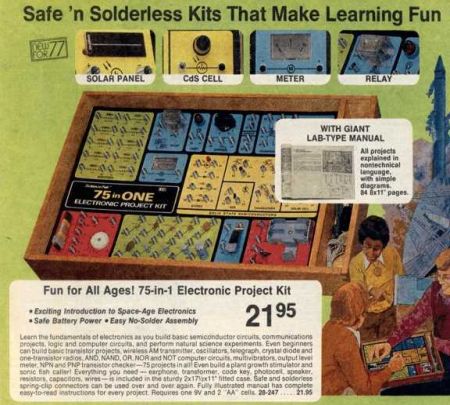
I also bought a 9-volt adapter that allowed me to plug the kit into the wall ( for the 9V source ) so that I wouldn’t have to mess around with batteries.
I built a project in this kit called a “spark-gap generator.” It created electrical interference when the Morse code key was pressed. You could just put it by a radio on an empty station and could hear a buzz as you depressed the key.
I connected the wires from the key directly to the power source and could hear a continuous buzz. I went to the kitchen to get a drink and found that my dad was desperately trying to adjust the TV antenna for the football game he was watching. My project was broadcasting enough interference that it caused very erratic blurring to the TV video along with the buzz on the audio. I ran in and shut it down.
Radio Shack then began to stock a line of products that would play a big role in my future:
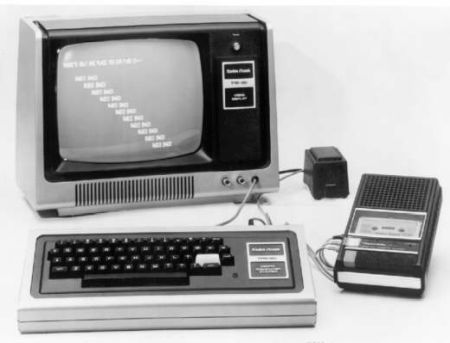


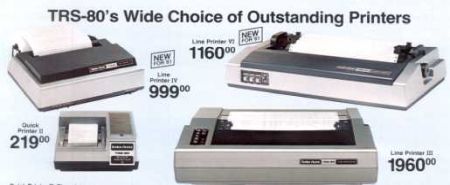
Can you believe that a good desktop printer in 1980 ran a couple of thousand dollars? Of the above, my dad owned a TRS-80 pocket computer, but I used it almost exclusively. ( I still have it. )
I later got a used TRS-80 and more recently obtained a used TRS-80 Color Computer (CoCo). I purchased a few books at Radio Shack including Going Ahead with Extended Color BASIC, Microsoft BASIC Decoded and Other Mysteries, and More TRS-80 Assembly Language. I bought a small hand-held amplifier from Radio Shack so that I could listen to the sound-effects from TRS-80 games.
As we crept into the mid-80’s, Radio Shack began the abandonment of its unique line of computers so that it could re-sell “IBM PC compatibles.” I bought different brands of computers and visited Radio Shack a little less.
I did spot a sale on a Radio Shack shortwave radio kit when I was in college:
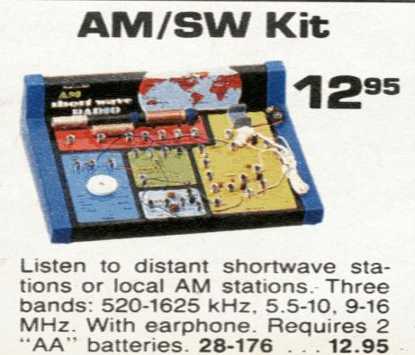
I bought the kit for $10. I ran the output intended for a crystal earphone into an amplifier. I was able to hear various English language broadcasts including Armed Forces Radio, the BBC, and The Atomic Clock. There were many, many foreign-language broadcasts that I could pick up, too. I still have this kit. I should reassemble the receiver and give it a listen.
When I had the need for a burglar alarm in one of my early apartments, I bought this one:

It held to a door with an adhesive. Once armed, a simple motion would trigger a loud, annoying alarm sound. I kept this attached to my front door. Unfortunately, if a neighbor ordered a pizza or just came home late, the entrance door would close causing the air to nudge my door just enough to trigger the alarm. It worked well and was simple to use, though.
I bought a handful of Radio Shack’s signature AM “flavoradios” as Christmas gifts for my young cousins. However, personal FM stereos had gotten cheap enough that I was a bit behind-the-times with my gift choice.
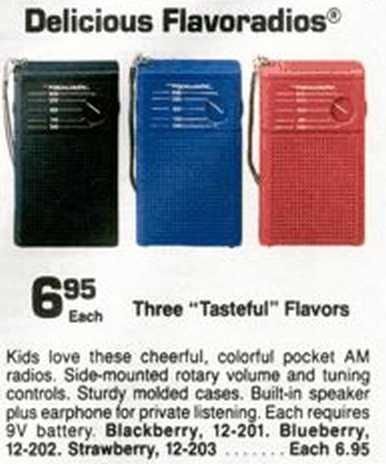
I wanted to get the “Patrolman” multi-band radio at the time, but couldn’t afford it:
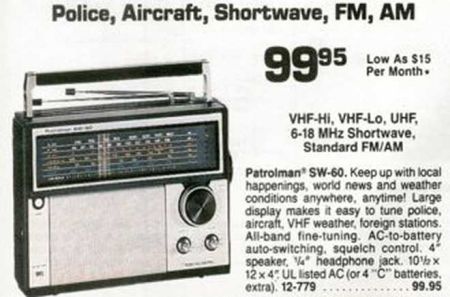
I got a used one from a pawn shop. It lasted me almost twenty years. Among the many other band selections, there were a couple of shortwave bands. I ran a wire from the antenna to a long sheet of aluminum foil stretched along the ceiling of two adjacent walls in my apartment. I was able to receive all kinds of stuff on those shortwave bands. One of the last programs I had listened to on that radio was a shortwave rebroadcast of the Off the Hook radio show from WBAI-FM, New York.
For a while, I mainly went to Radio Shack to get computer cables and telephone gear. I bought a small AM/FM pocket radio there. I also picked up a meter and a number of the Forrest Mims III “Engineers’ Notebook” books.
As Radio Shack’s core business seemed to move toward mobile phones and satellite TV I frequented the stores less and less.
I stopped in to a store and bought an LED Christmas tree kit a couple of months ago. I had wondered just how long that store was going to be around. I will try to stay tuned to the bankruptcy process, but I wonder if the company is finally going to have to shut down.